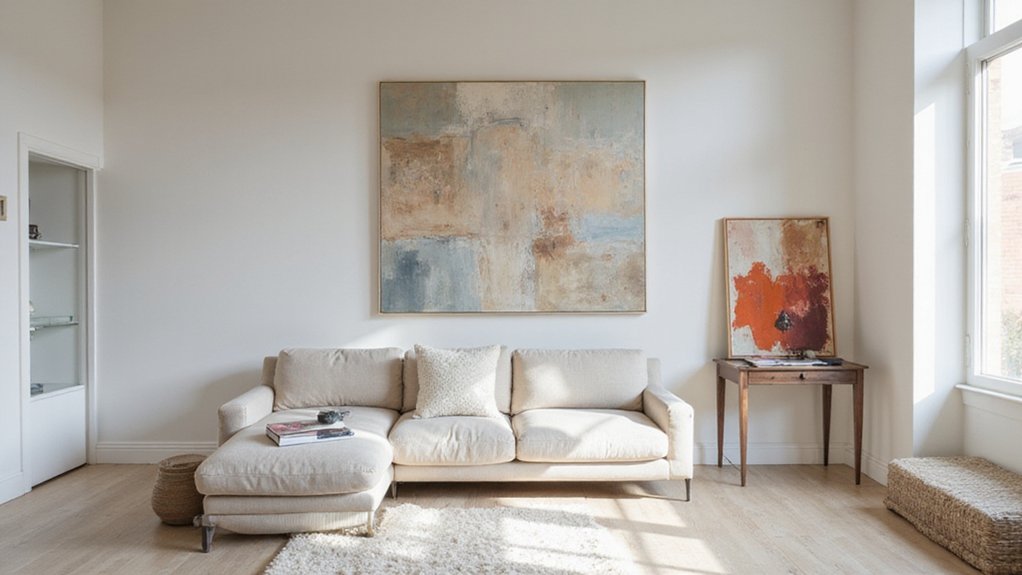You’re about to tackle painting your open concept living space. You’ll need a unifying color scheme – but where do you start?
Choosing a Unifying Color Scheme
Because a unifying color scheme is essential in open concept living spaces, you’ll want to choose a palette that ties the entire area together seamlessly. You’re creating a sense of belonging by selecting colors that work well together.
Mixing complementary colors can add depth and visual interest to your space. When balancing warm and cool tones, consider the natural light and furniture in the area. Warm tones, like beige and orange, can create a cozy atmosphere, while cool tones, like blue and green, can make the space feel calming. For professional guidance, consult experts who offer premium paint selections to ensure your color scheme enhances your home’s unique character.
Creating Visual Boundaries
You’ve selected a unifying color scheme that ties your open concept living space together – now it’s time to define different areas within the space. You’re creating a sense of belonging by defining visual zones that serve specific purposes.
To achieve this, you’ll establish focal points that draw the eye to specific areas, such as a statement piece of art or a designer feature. By doing so, you’ll create a sense of separation between different areas, like a living zone and a dining zone.
This will help you create a functional and harmonious space that feels cohesive and inviting. Establishing focal points and defining visual zones will help you create a sense of flow and balance in your open concept living space, making it feel more intimate and welcoming. For personalized guidance, consider consulting professionals who can offer color selection suggestions to enhance the coziness or brightness of your space.
Selecting Paint Colors for Open Spaces
When selecting paint colors for open spaces, it’s paramount to ponder the overall aesthetic you want to attain, as the appropriate color can make or shatter the ambiance of your open concept living space. You’re creating a sense of belonging by choosing colors that reflect your personality.
Considering lighting effects is indispensable, as natural and artificial light can impact the color’s appearance. Evaluating wall finishes is also imperative, as different textures and materials can affect how the paint color looks. You’ll want to test samples on your walls to see how they interact with the lighting and finishes.
Considering Lighting and Shadows
Selecting the perfect paint color is just the starting point – it’s how that color interacts with the lighting and shadows in your open concept living space that really brings the room to life. You’re creating a sense of belonging by highlighting natural light and manipulating shadows.
Consider the direction of natural light
Think about the color temperature of lighting fixtures
Use paint to reflect or absorb light
Manipulating shadows can add depth to a room
Balancing light and dark creates visual interest, making you feel connected to the space.
Painting Strategies for Large Areas
As you tackle painting a large open concept living space, the sheer scale of the area demands a thoughtful approach to guarantee a cohesive look. You’ll want to contemplate using primer to confirm a uniform base tone, which is imperative for achieving an even finish. This step is especially important in large areas where minor inconsistencies can become amplified.
Coordinating With Furniture and Decor
Because you’re working with a large, open concept living space, you’ll want to choose a paint color that complements your furniture and decor, creating a sense of harmony throughout the area. This involves magnifying texture and accentuating focal points to create a cohesive look.
- Consider the color of your furniture and decor
- Think about the style of your space
- Choose a paint color that ties everything together
- Magnify texture with a semi-gloss or eggshell finish
- Accentuate focal points with a bold, contrasting color to create a sense of belonging in your space.
Testing and Refining Your Color Choices
When you’ve narrowed down your paint color options, it’s time to test and hone them, which involves applying samples to your walls and observing how they interact with your space’s unique lighting conditions. You’re experimenting with color samples to find the perfect fit for your open concept living space.
Evaluating lighting effects is essential, as natural and artificial light can drastically impact the color’s appearance. Consider the time of day and lighting sources when testing samples. By doing so, you’ll gain a better understanding of how the colors will look in different scenarios, allowing you to make an informed decision.
This process helps you refine your color choices, ensuring the final result is cohesive and inviting, making your space feel like home.
Frequently Asked Questions
Can I Paint Over Wallpaper?
You’re considering painting over wallpaper, but first, you’ll need to grasp proper wallpaper removal techniques or test for stubborn adhesive to guarantee a smooth finish.
How Often Repaint Open Spaces?
You determine the frequency of repainting by considering usage, extending paint life with quality products, and evaluating wear, ensuring a fresh, welcoming space that makes you feel at home always.
Are Primer Coats Necessary?
You’re wondering if primer coats are necessary, considering advanced paint application techniques, and whether a roller or brush is best, to achieve a flawless finish in your space.
Can I Paint Ceilings White?
You’re wondering if you can paint ceilings white, which works well with lighter shades, creating a uniform finish that makes your space feel cohesive and inviting, don’t you?
Do I Need Paint Permits?
You’re checking if you need paint permits, so research your local building codes and permit requirements to guarantee you’re complying with regulations, it’s imperative you understand them.

